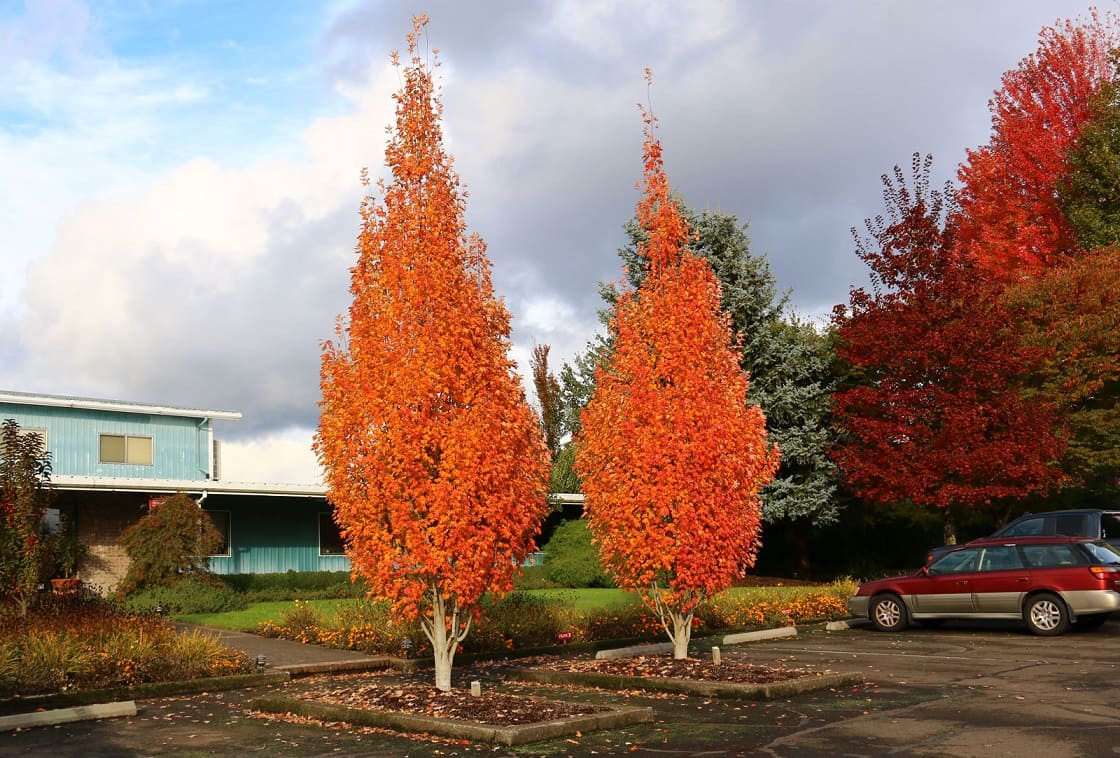I’ll never forget the day my neighbor knocked on my door, clearly frustrated. “I want trees for privacy,” she said, “but my yard is only twelve feet wide. Everyone says I can’t have trees.”
Six months later, she had a stunning row of Emerald Green Arborvitae creating the perfect natural screen, each tree standing tall and elegant without crowding her tiny urban lot. That’s the magic of columnar trees – they give you all the benefits of larger trees in a fraction of the space.
Whether you’re dealing with a narrow side yard, a small urban lot, or simply want to add dramatic vertical interest to your landscape, columnar trees are nature’s skyscrapers, designed specifically for modern living challenges.
Understanding Columnar Trees: Nature’s Architectural Marvels
Columnar trees grow tall and narrow rather than wide and spreading, typically maintaining a height-to-width ratio of at least 5-to-1, with some reaching an impressive 10-to-1 ratio. Think of them as living exclamation points that add instant drama and structure to any space.
The term “columnar” is often used interchangeably with “fastigiate,” though there’s a subtle difference. Fastigiate trees have branches that grow nearly parallel to the trunk, reaching upward like arms in celebration.
Columnar trees achieve their narrow profile through various means – some have naturally short side branches, others have weeping branches that hug the trunk, and some are simply compact versions of their wider cousins.
This unique growth habit isn’t accidental. Most columnar varieties are carefully selected mutations or specially bred cultivars that have been propagated to maintain their distinctive narrow form.
What makes this even more interesting is that many of these varieties were discovered by chance – a single aberrant tree in a cemetery, a mutation spotted by a sharp-eyed nurseryman, or a lucky seedling that grew differently from thousands of others.
Why Columnar Trees Are Perfect for Modern Gardens
The average American yard has been shrinking for decades, yet our desire for greenery and privacy hasn’t diminished. Columnar trees solve this puzzle elegantly while offering benefits that go far beyond space efficiency.
- Space Efficiency That Actually Works – A traditional oak might need 50 feet of clearance in all directions, while a Kindred Spirit Oak achieves similar height and impact in just 6 feet of width. This isn’t about compromise; it’s about smart design that maximizes vertical space.
- Instant Architectural Drama – These trees create what landscape designers call “vertical punctuation.” They draw the eye upward, making spaces feel larger and more sophisticated. Even a single specimen can transform an ordinary garden bed into something that looks professionally designed.
- Quick Privacy Solutions – Plant columnar trees 3-6 feet apart, and you’ll have an elegant living wall that provides privacy without the bulk of traditional hedging. Many varieties grow surprisingly quickly, with some adding 2-3 feet of height per year.
- Urban Champions – City gardens face unique challenges including air pollution, limited soil, reflected heat, and salt spray from winter road treatments. Many columnar varieties have been specifically selected for their urban toughness and thrive in conditions that would stress traditional shade trees.
Climate Considerations: Matching Trees to Your Zone
One of the most overlooked aspects of columnar tree selection is climate compatibility. Unlike their full-sized relatives, many columnar varieties have been bred for specific conditions, and understanding your hardiness zone is crucial for success.
- Cold Climate Champions (Zones 3-5) – Northern gardeners have excellent options including Pyramidal European Hornbeam, which tolerates temperatures down to -40°F, and Swedish Columnar Aspen, hardy to Zone 2. Taylor Juniper performs beautifully in these harsh conditions while providing year-round color.
- Moderate Climate Winners (Zones 6-8) – This sweet spot offers the widest selection. Here you can grow everything from Kindred Spirit Oak to Sky Pencil Holly, along with most fruiting varieties. These zones provide enough winter chill for fruit trees while staying warm enough for more tender evergreens.
- Warm Climate Solutions (Zones 9-11) – Southern gardeners should focus on heat-tolerant varieties like Italian Cypress and certain palm species. Many northern favorites struggle with intense summer heat and humidity, so local adaptation becomes critical.
The key is choosing varieties that not only survive but thrive in your specific climate. A tree that merely survives will never achieve the full beauty and performance you’re hoping for.
The Best Columnar Trees by Purpose and Climate
Evergreen Columnar Trees: Year-Round Backbone Plants
Arborvitae Selections – The Privacy Screen Champions
Arborvitae varieties remain the gold standard for columnar evergreens, offering reliable performance across a wide range of climates.
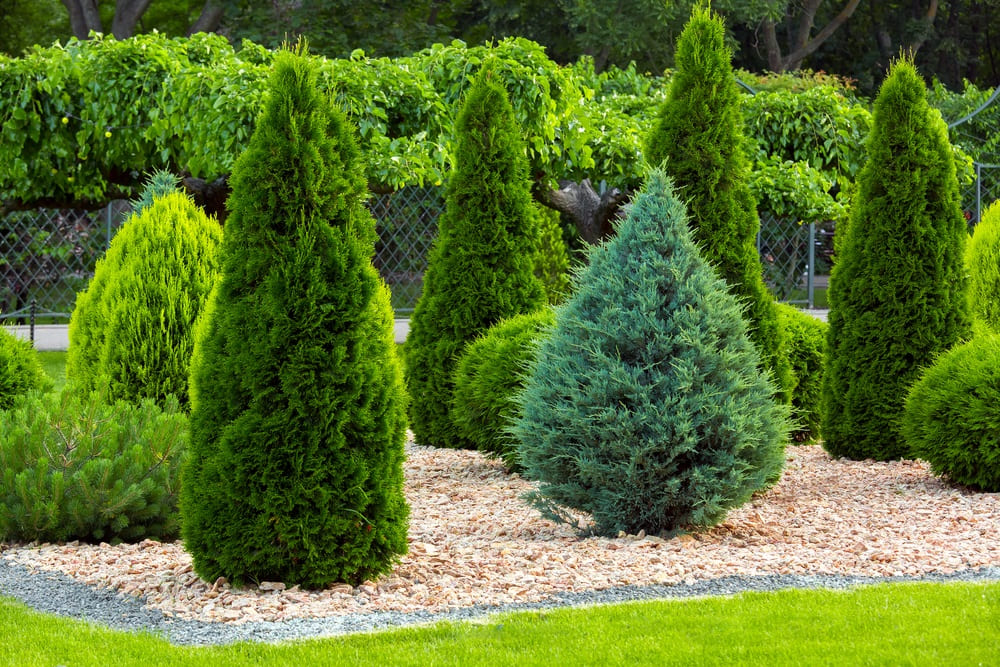
- Emerald Green Arborvitae has earned its reputation through decades of consistent performance, growing 12-14 feet tall and just 3-4 feet wide while maintaining bright green color year-round.
- American Pillar Arborvitae offers faster growth with similar proportions, reaching 25 feet tall and 4-5 feet wide with notably uniform density.
- DeGroot’s Spire Arborvitae presents the narrowest option, growing 20 feet tall but only 4 feet wide with distinctive spirally arranged foliage that creates unique texture.
- North Pole Arborvitae stays more compact at 10-15 feet tall, making it perfect for smaller spaces.
- Holmstrup Arborvitae offers exceptional cold hardiness with its dense, dark green foliage in a compact 8-12 feet tall form.
Juniper Varieties – The Drought-Tolerant Performers
Junipers provide unmatched versatility and toughness in columnar form.
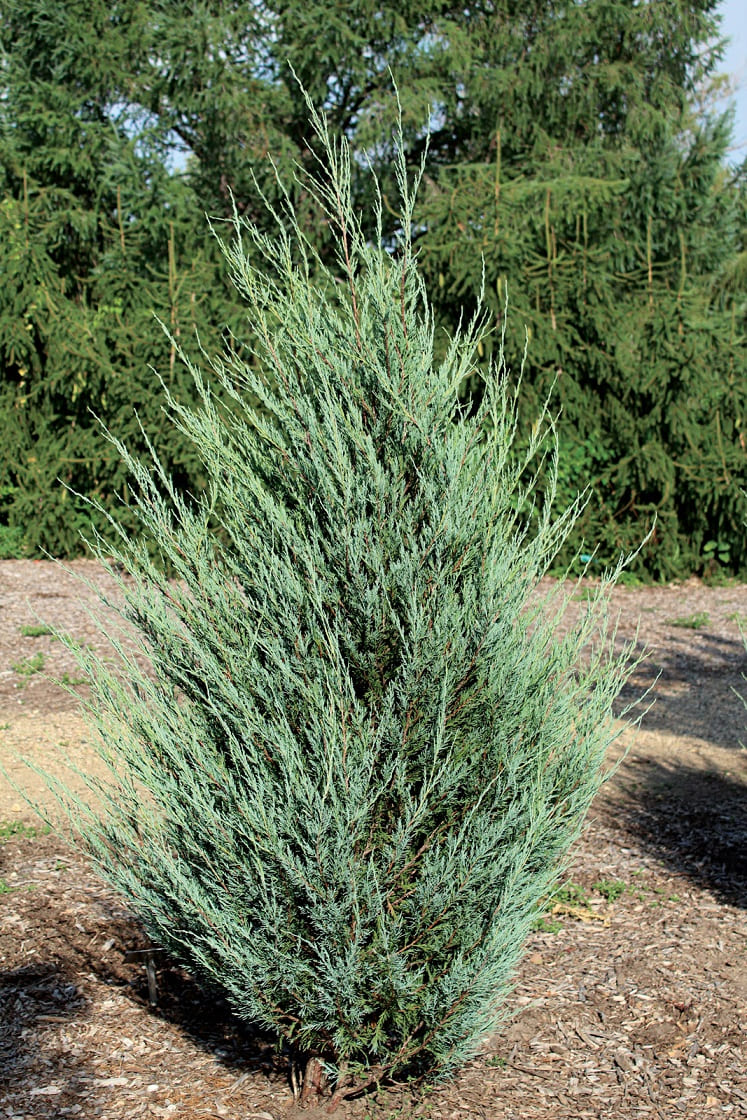
- Taylor Juniper combines silvery-blue foliage with impressive drought tolerance, growing to 20 feet tall and 4 feet wide while requiring virtually no maintenance.
- Skyrocket Juniper lives up to its name with an extremely narrow profile of 18-30 feet tall and just 2-3 feet wide, making it perfect for the tightest spaces.
- Blue Arrow Juniper offers similar proportions with striking blue foliage that provides year-round color contrast.
- Spartan Juniper grows slightly wider at 15-20 feet tall and 4-5 feet wide but offers dense branching that’s excellent for screening.
- Blue Point Juniper stays more compact at 10-12 feet tall and provides beautiful blue-green color.
- Wichita Blue Juniper offers light silvery-blue foliage in a 15-18 foot tall package.
- For those seeking unique characteristics, Gray Gleam Juniper provides silvery-gray color without fruit production (being a male cultivar).
- Moonglow Juniper offers blue-gray foliage with excellent urban tolerance.
- Woodward Juniper has been selected for superior snow load resistance, making it ideal for heavy snow regions.
Spruce Selections – The Formal Garden Stars
Spruce varieties bring formal elegance with their structured growth habits.

- Columnar Colorado Blue Spruce showcases dramatic silver-blue foliage in a neat 25-foot tall, 7-foot wide form that maintains its shape without pruning.
- Columnar Norway Spruce offers classic dark green color in a 30-foot tall, 10-foot wide package.
- Weeping White Spruce provides unique character with its pendulous branches creating graceful movement around a strong central leader.
- For smaller spaces, Baby Blue Eyes Spruce stays compact at 15 feet tall with beautiful blue needle color
- North Star White Spruce offers dense, dark green needles in a 15-foot tall form.
- Blue Totem Blue Spruce provides sharp-angled branches with very blue color in an 18-foot tall package.
Pine Varieties – The Textural Interest Providers
Columnar pines offer bold texture and character.
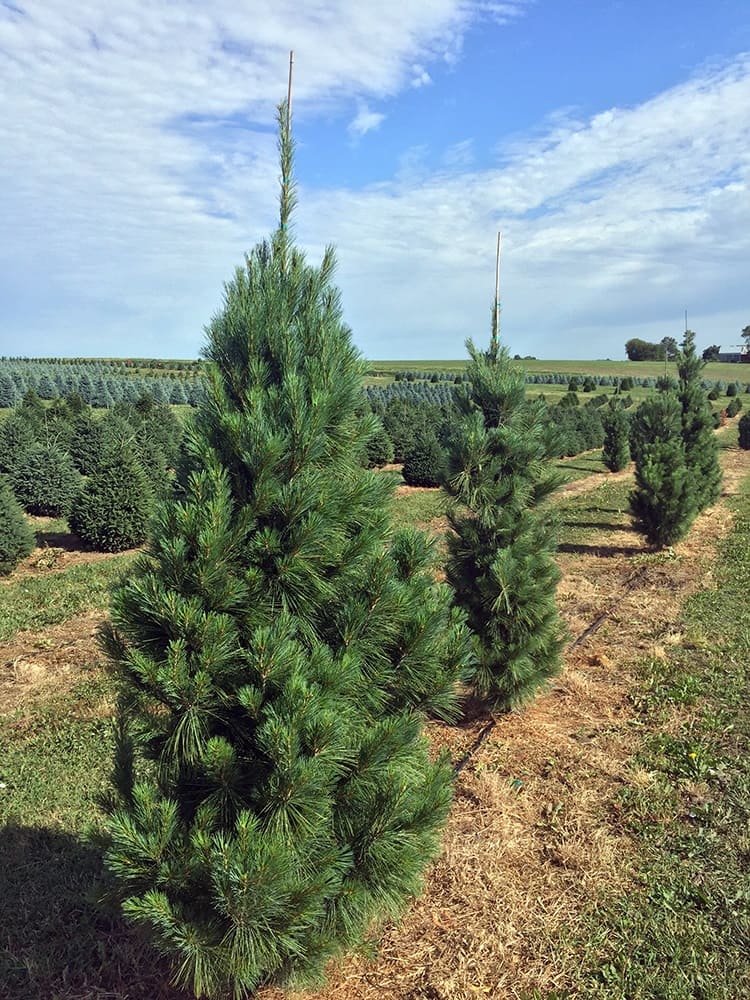
- Arnold Sentinel Austrian Pine presents dark needles on upswept branches in a rigidly columnar 20-25 foot tall silhouette, though it can be prone to storm damage due to longer needles.
- Fastigiate Scots Pine offers blue-green needles with distinctive reddish bark in a narrow 20-foot tall form.
- Various Bosnian Pine selections including ‘Compact Gem,’ ‘Emerald Arrow,’ and ‘Satelit’ provide stiff, very dark green needles with excellent salt tolerance and slow, steady growth.
Specialty Evergreens – The Unique Characters
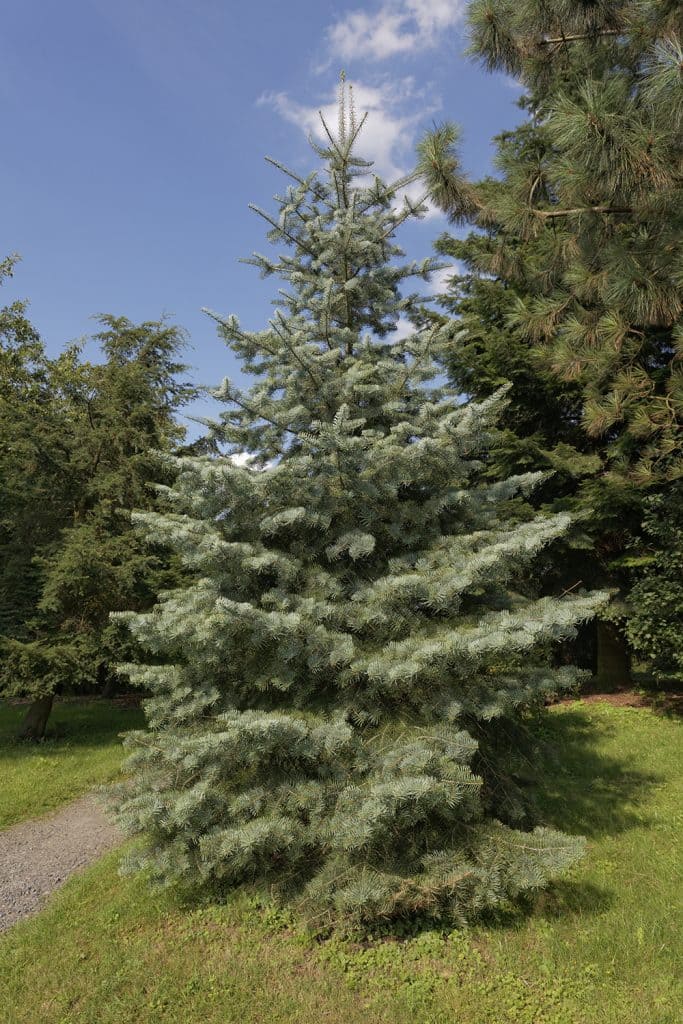
- Sky Pencil Holly remains the ultimate small-space solution at just 6-8 feet tall and 2-3 feet wide, with glossy leaves and excellent deer resistance.
- Dragon Lady Holly offers a pyramidal form with vibrant red berries for winter interest.
- Italian Cypress brings Mediterranean elegance to warm climates, reaching 40-60 feet tall while staying incredibly narrow.
- Blue Italian Cypress provides the same dramatic form with blue-green foliage.
- Joe Kozey Japanese Umbrella Pine offers unique texture with thick, rubbery needles and superior snow load tolerance.
- Green Arrow Nootka Cypress provides weeping branches held close to a strong central leader for distinctive character.
- Conical White Fir showcases powder blue foliage that’s noteworthy year-round in a compact 10-15 foot form.
Deciduous Columnar Trees: Seasonal Drama and Color
Oak Varieties – The Stately Performers
Columnar oaks combine the majesty of traditional oaks with manageable proportions.

- Kindred Spirit Oak reaches 30 feet tall and 6 feet wide with silvery-backed leaves that flutter beautifully and provide golden fall color.
- Regal Prince Oak grows larger at 45-50 feet tall and 18-25 feet wide, offering excellent urban tolerance and brownish-yellow fall color.
- Crimson Spire Oak provides dark green summer foliage that turns stunning rusty red in fall, reaching 40 feet tall and 15 feet wide.
- Street Spire Oak and Streetspire Oak (different selections) both offer excellent urban performance with heights of 45 feet and spreads of 15 feet, featuring reliable red fall color.
- Urban Pinnacle Oak grows to 55 feet tall and 25 feet wide, providing classic oak character in a more manageable upright oval form.
- Beacon Oak excels in parkway plantings, reaching 40 feet tall and 15 feet wide with excellent urban tolerance.
- For more formal applications, Columnar English Oak (‘Fastigiata’) grows to 50 feet tall with an 8-foot spread,
- Skyrocket English Oak offers an even more columnar form at 35 feet tall and 10 feet wide.
Maple Varieties – The Fall Color Champions
Maples provide some of the most reliable fall color in columnar form.

- Armstrong Gold Red Maple offers medium-deep green summer leaves that turn brilliant golden-orange in fall, growing 40 feet tall and 12 feet wide with tightly branched structure.
- Armstrong Red Maple (the original) grows slightly larger at 60 feet tall and 10-15 feet wide with reliable red fall color when conditions are right.
- ‘Monumentale’ Sugar Maple (also called ‘Temple’s Upright’) provides the classic sugar maple experience in a 30-foot tall, 3-foot wide package with excellent orange fall color.
- ‘Newton Sentry’ Sugar Maple offers similar proportions but with even narrower growth, discovered in Newton Cemetery, Massachusetts, and prized for its uniform, extremely narrow habit.
👉 Unlocking the Benefits of Sugar Maple Trees for Small Farms Beyond Maple Syrup
Birch and Hornbeam – The Textural Specialists

- Parkland Pillar Asian White Birch combines narrow, upright growth with golden fall color and distinctive white bark, reaching 40 feet tall and 6 feet wide with excellent heat and drought tolerance.
- Pyramidal European Hornbeam (‘Fastigiata’) creates a dense pyramid of textured leaves that turn yellow in fall, growing 35 feet tall and 15-25 feet wide depending on age.
- Frans Fontaine Hornbeam offers one of the narrower hornbeam selections at 25-30 feet tall and 15 feet wide with interesting bark texture.
Specialty Deciduous Trees – The Unique Performers
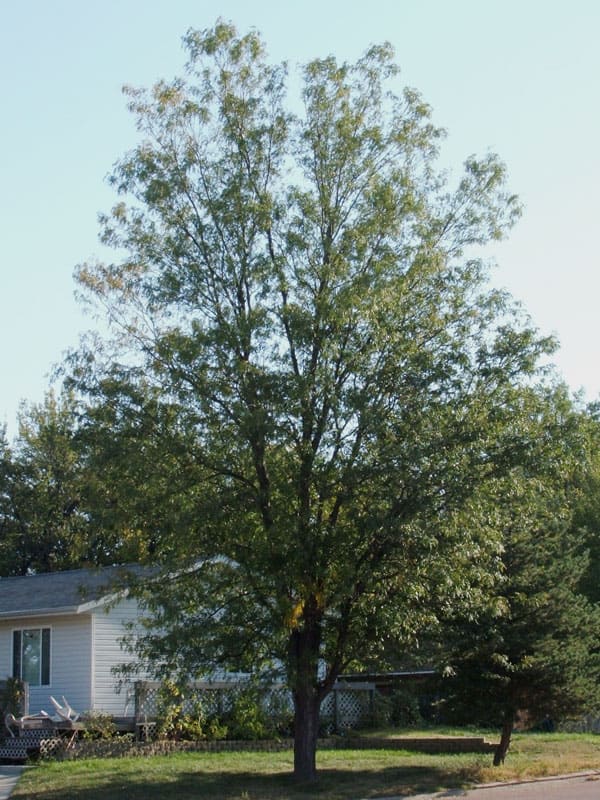
- Prairie Sentinel Hackberry excels in tough urban conditions with extreme tolerance for drought, heat, cold, wind, and pollution. Growing 40-45 feet tall and 10-12 feet wide, it features upswept branches in a tightly fastigiate form with yellow fall color.
- Slender Silhouette Sweetgum stands out with its incredibly narrow profile of 40-60 feet tall and just 4-6 feet wide, producing spectacular fall color in orange, red, purple, and yellow. Unlike regular sweetgums, it produces relatively few seed balls.
- Musashino Japanese Zelkova was named 2016 Urban Tree of the Year by the Society of Municipal Arborists for its adaptability to harsh urban conditions. Growing 45 feet tall and 15 feet wide, it offers serrated leaves that turn yellow to rusty red-orange in fall.
- Northern Sentinel Honeylocust provides fine-textured foliage that casts filtered shade, reaching 45 feet tall and 25 feet wide with yellow fall color and excellent ice and snow resistance.
Ginkgo Selections – The Living Fossils
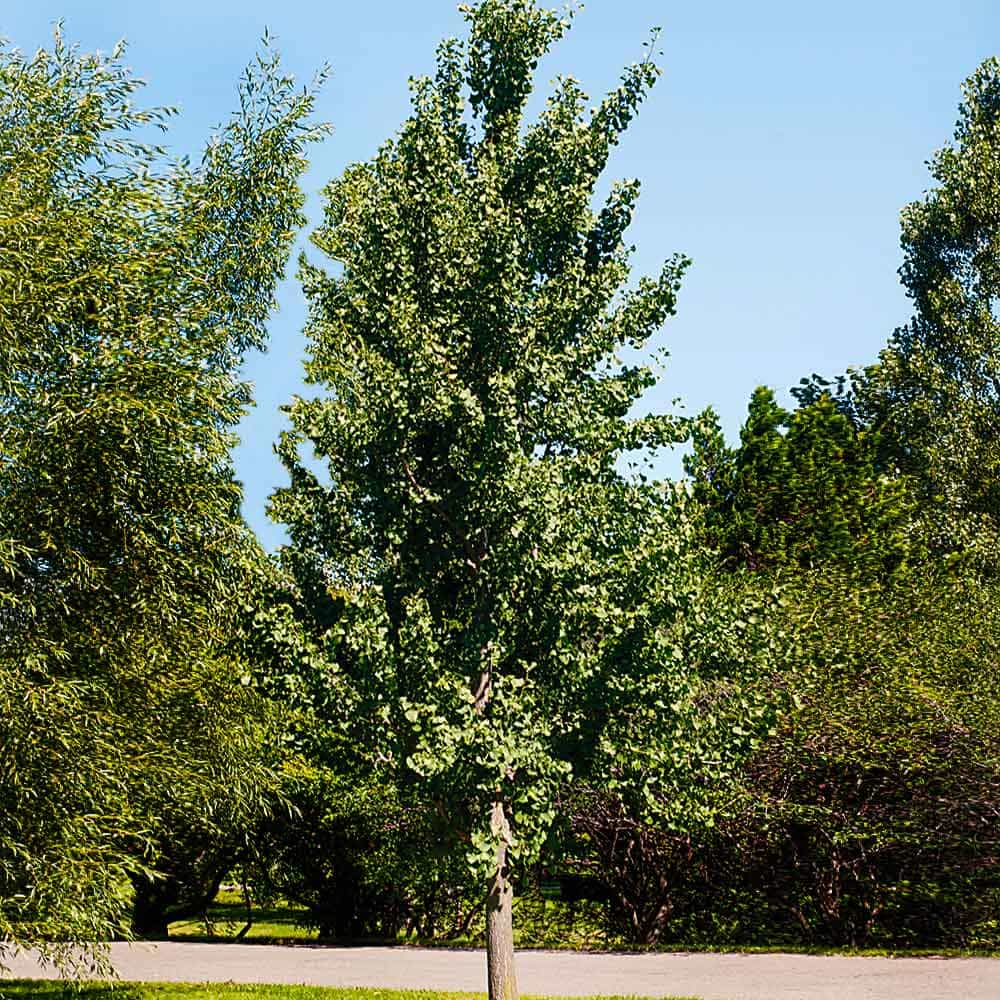
- Princeton Sentry Ginkgo offers the unique fan-shaped leaves and brilliant yellow fall color of ginkgos in a columnar 40-60 feet tall, 15-20 feet wide form. Being a male selection, it won’t produce the messy fruits.
- Goldspire Ginkgo provides similar characteristics in a more compact 25 feet tall, 7 feet wide package, perfect for smaller spaces.
Unique Flowering Trees
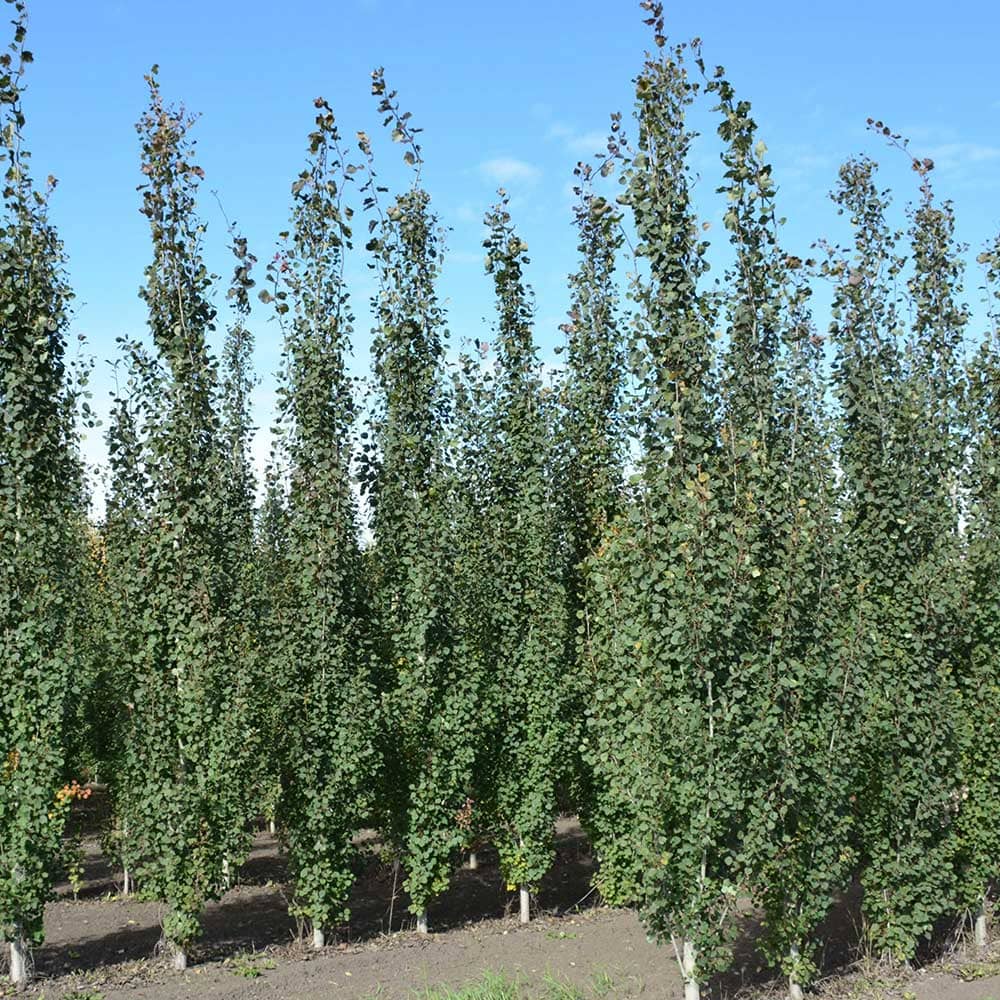
- ‘Sunspire’ Magnolia presents a rare upright magnolia with deep yellow flowers held upright, reaching 25 feet tall and 8 feet wide. The flowers arrive late in spring, avoiding most frost damage.
- Persian Spire Parrotia offers refined foliage that emerges purple and matures to green with purple margins, providing bright orange, red, and yellow fall color in a 25 feet tall, 10 feet wide package.
- Fastigiate Tulip Tree grows to impressive heights while maintaining columnar form, though it may not flower as readily as spreading forms.
- Swedish Columnar Aspen provides dramatic transitioning foliage from bronze-red in spring to green in summer and yellow-red in fall, with the characteristic rustling sound of aspen leaves.
Flowering Columnar Trees: Ornamental Spectacles
Cherry Varieties – The Spring Show-Stoppers
Columnar cherries provide spectacular spring displays without the spreading canopy of traditional varieties.
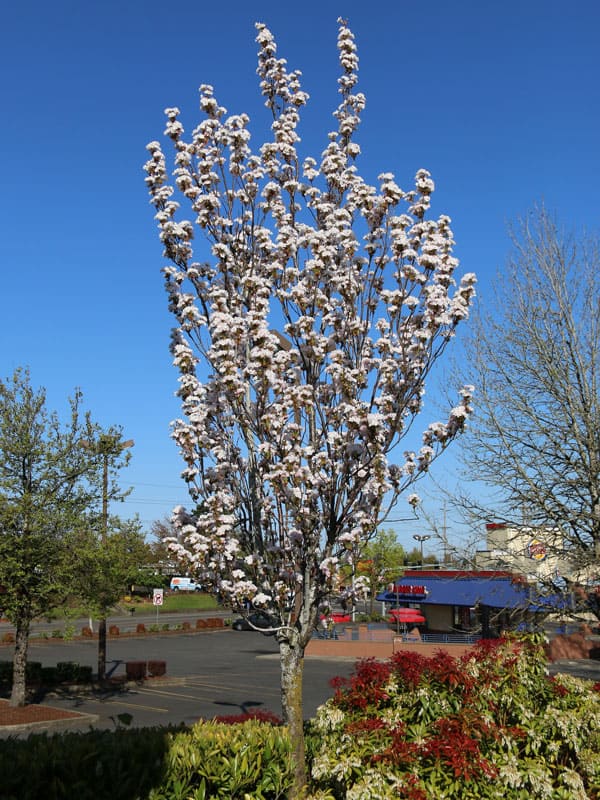
- ‘Amanogawa’ Cherry offers pale pink blossoms in late spring followed by orange and red fall color, growing 25-30 feet tall and 6-8 feet wide.
- ‘Columnaris’ Sargent Cherry features upward-sweeping branches with clusters of pink flowers, reaching 30 feet tall and 20 feet wide at maturity.
- Japanese Spire Cherry and various other spire selections provide similar spring beauty in narrow forms perfect for tight spaces or formal plantings.
👉 Related post: Foraging Wild Cherries: Discovering The Nature’s Delights
Crabapple Selections – The Multi-Season Performers
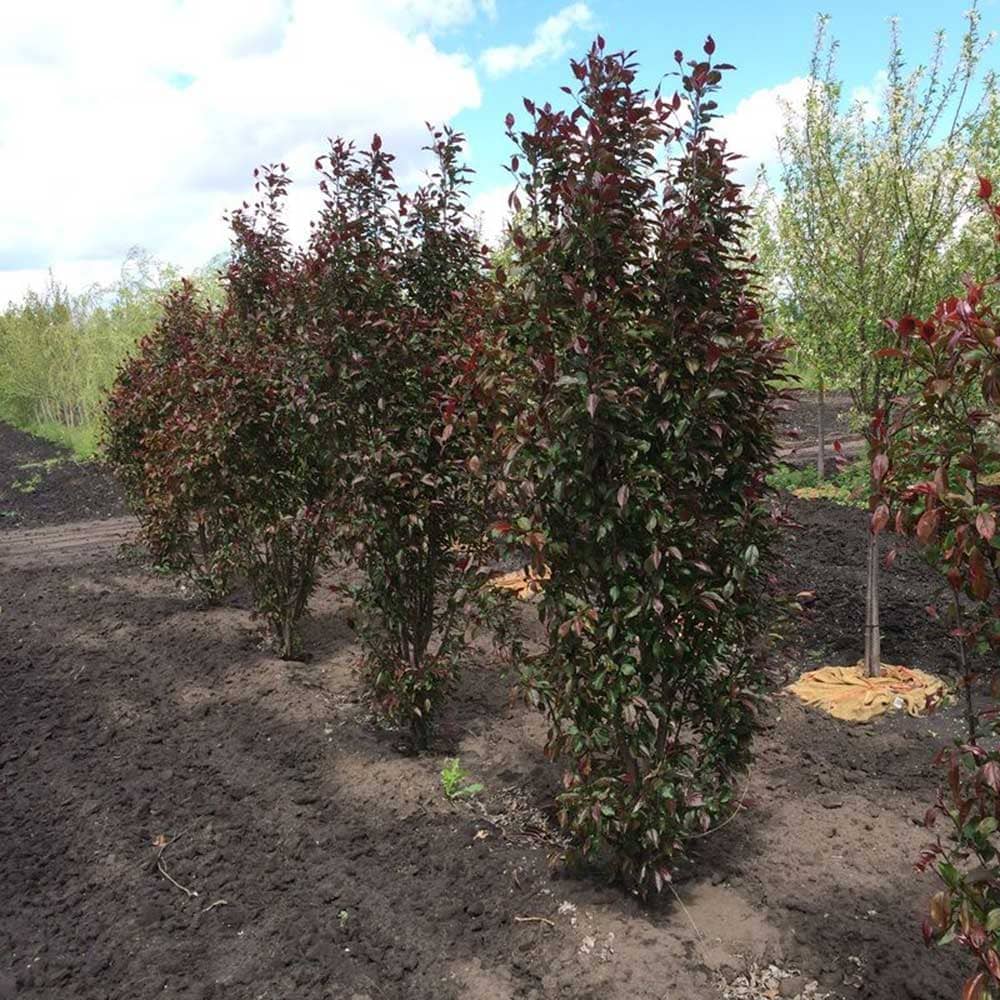
- Purple Spire Crabapple and Raspberry Spear Crabapple offer bright pinkish-purple flowers in spring followed by small ornamental fruits.
- Red Jewel Crabapple provides white flowers that coat the branches, followed by small red fruit that persists through fall and winter, growing 15 feet tall and 12 feet wide.
- Red Baron Crabapple features reddish-purple spring foliage that turns bronze-green, with dark red flowers and fruit in a narrow 20-foot tall, 4-foot wide form.
Plum Varieties – The Foliage and Flower Combination
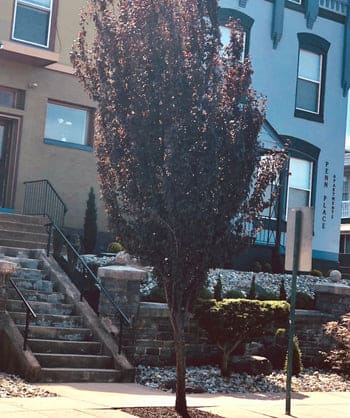
- Crimson Pointe Purple Leaf Plum (‘Crimson Pointe’) combines deep purple foliage with fragrant white spring flowers, growing 20-25 feet tall and just 6 feet wide. This makes an excellent specimen or can be planted in rows for colorful screening.
- Columnar Plum Tree selections offer similar characteristics with various foliage colors and growth habits, perfect for adding color and spring interest to narrow spaces.
Columnar Fruit Trees: Productive Beauty
Apple Varieties – The Space-Saving Orchards
True columnar apple varieties represent a revolution in small-space fruit growing.
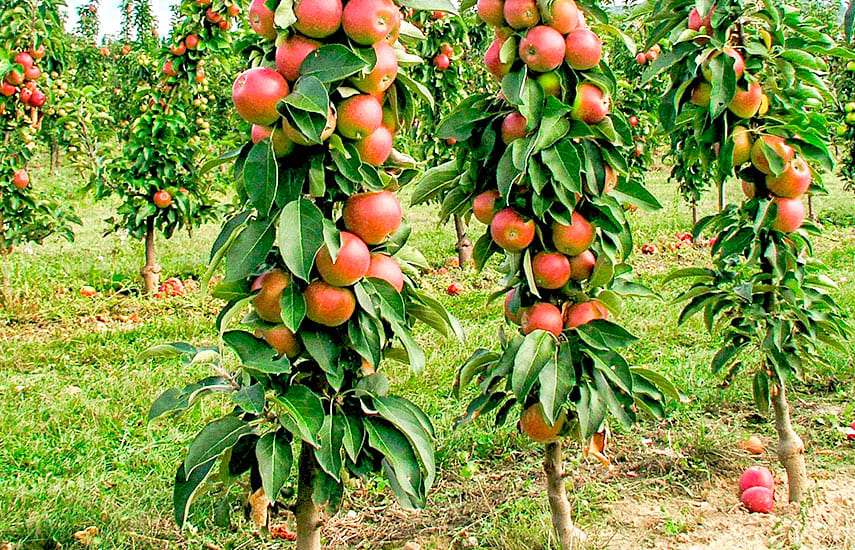
- North Pole Apple produces full-sized green apples on trees just 8-12 feet tall and 2-3 feet wide, often fruiting in the first year after planting.
- Scarlet Sentinel Apple offers red apples with similar compact growth.
- Golden Sentinel Apple provides yellow fruit.
- Modern varieties like Maypole Apple feature red flesh and even reddish foliage, creating ornamental value beyond fruit production.
- Greencats, Redcats, Goldcats, and Starcats apples offer disease resistance improvements over older varieties while maintaining the narrow growth habit.
- For those preferring traditional varieties, selections like Red Sensation and Green Sensation provide familiar flavors in columnar form, though these may require more annual pruning to maintain shape.
👉 Read the Ultimate Guide for Beginners to Growing Apples and Apple Trees
Pear Varieties – The Elegant Fruit Trees

- Javelin Pear stands out for its excellent fireblight resistance and tightly columnar form, with leaves that emerge purple and turn bronze-green.
- Mountain Frost Pear offers similar disease resistance with glossy green leaves and red-purple fall color.
- Chanticleer Pear (also called Cleveland Select) provides white spring flowers and excellent fall color while producing few fruits.
👉 Find out Why Bradford Pear Trees Are Bad for Your Garden: The Invasive Truth
Stone Fruit Selections
- Weeping Persimmon offers unique character with branches that start upright then curve downward, creating a distinctive weeping form. The thick, jade-colored leaves turn brilliant autumn colors before dropping to reveal sweet orange fruit in late fall.
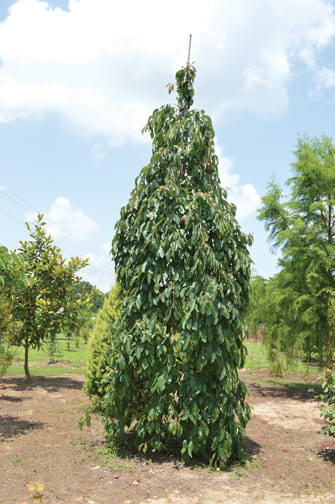
Various columnar cherry, plum, and mirabelle selections provide options for those wanting stone fruits in narrow forms, though availability may be limited compared to apple and pear varieties.
👉 Here’s How to Grow a Thriving Backyard Orchard (Even in Small Spaces)
Strategic Landscape Applications
Creating Living Architecture
One of the most effective applications is using columnar trees as “living posts” to define outdoor spaces. Place a pair at the entrance to a seating area, or use them to frame a significant view. Unlike static hardscape elements, these grow more beautiful and valuable over time.
👉 Read The Complete Guide to Hedgerows: Wildlife Havens for Your Property
Privacy Screens That Work
Traditional privacy screens rely on horizontal growth, requiring significant depth. Columnar trees flip this concept, creating privacy through height rather than width.
The key is proper spacing – plant Emerald Green Arborvitae 4 feet apart for a solid screen that fills in quickly, or space them 6 feet apart for a more open, rhythmic pattern that allows glimpses through while still providing privacy.
Container Gardening Solutions
Many columnar varieties thrive in containers, opening possibilities for renters, balcony gardeners, and anyone wanting moveable privacy. A 20-gallon container can support most smaller varieties for several years. The key is choosing naturally compact varieties and planning for eventual repotting or replacement.
Urban and Streetscape Applications
That challenging strip between sidewalk and street becomes a perfect opportunity with the right columnar trees.
Varieties like Crimson Spire Oak or Parkland Pillar Birch provide shade and beauty without interfering with power lines or blocking sight lines for traffic safety. Municipal planners increasingly specify columnar trees for these challenging urban locations.
Planting for Long-Term Success
Site Selection Strategy
Despite their narrow width, columnar trees are still trees with substantial root systems. Choose locations with at least 6 feet from structures to allow for root development, adequate clearance from overhead utilities, and soil that drains well but retains some moisture.
Most varieties need at least 6 hours of direct sunlight, though some like Sky Pencil Holly tolerate partial shade.
Soil Preparation That Makes a Difference
Most columnar trees adapt to various soil conditions, but they’ll thrive with proper preparation. The ideal soil pH ranges from 6.0-7.0 for most varieties, though some like Sky Pencil Holly prefer slightly acidic conditions (5.5-6.5). Test your soil and amend accordingly – sulfur lowers pH while lime raises it.
Mix compost into the backfill soil at about a 30% ratio, but avoid creating a “bathtub effect” by making the planting hole soil too different from surrounding native soil. This can actually impede root development by creating a barrier between different soil types.
👉 Here’s How to Prepare Land for Planting: A Comprehensive Guide for Gardeners and Farmers
Timing and Technique
Fall planting gives trees a full season to establish roots before facing summer stress, making it the ideal time in most climates. Spring is second-best, but avoid late spring planting in hot climates where trees might struggle with immediate heat stress.
The planting hole should be 2-3 times wider than the root ball but only as deep. The top of the root ball should be level with or slightly above the surrounding soil. Tall, narrow trees often need temporary staking, especially in windy locations, but use flexible ties and remove stakes after one growing season to encourage strong trunk development.
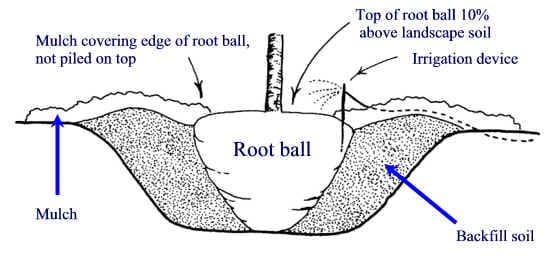
Year-Round Care for Thriving Trees
Watering Wisdom Through the Seasons
- Establishment Phase (First Year) – Newly planted trees need consistent moisture but not soggy conditions. Water deeply 2-3 times per week rather than daily light watering. A good test: if you can easily push a stick 6 inches into the soil, there’s adequate moisture.
- Mature Tree Maintenance – Most columnar varieties become quite drought-tolerant once established, typically after 2-3 years. However, consistent moisture produces the best growth and appearance. Container-grown specimens need more attention, often requiring daily watering during hot weather.
- Seasonal Adjustments – Reduce watering frequency in fall to help trees prepare for dormancy, but ensure adequate soil moisture going into winter, especially for evergreens that continue losing moisture through their foliage.
Fertilizing for Optimal Performance
Apply balanced, slow-release fertilizer in early spring as buds begin to swell. A 10-10-10 or similar balanced formula works well for most varieties. Container trees benefit from monthly feeding during the growing season, while in-ground trees typically need only the spring application unless growth appears unusually slow.
Stop fertilizing 6-8 weeks before expected frost to allow trees to properly harden off for winter. Late-season fertilizing can stimulate tender growth that’s susceptible to frost damage.
Pruning: Maintaining the Perfect Form
The beauty of columnar trees lies in their naturally good form, but understanding proper pruning techniques helps maintain their best appearance. Remove dead, damaged, or crossing branches during winter dormancy. This is also the time to remove any wayward branches that detract from the columnar form.
Summer touch-ups involve light pruning of new growth to maintain the narrowest profile. Pinch or cut new shoots back by half if they’re growing significantly wider than the rest of the canopy. Never top columnar trees by removing the central leader, as this destroys their natural form and can lead to weak, multiple leaders.
👉 Here’s How to Prune Roses: A Simple Guide for Stunning Results
Managing Common Challenges
Climate-Related Issues
- Snow Load Management – In areas with heavy wet snow, temporarily tie branches together with soft rope or fabric strips to prevent splaying. This is especially important for evergreen varieties with flexible branches. Remove ties once snow melts to allow natural movement.
- Salt and Urban Stress – For trees near roads or in urban environments, choose salt-tolerant varieties like Skyrocket Juniper or Taylor Juniper. Consider burlap screens during winter for more sensitive species, and ensure adequate soil moisture to help dilute salt concentrations.
- Wind Protection – While their narrow profile makes many varieties wind-resistant, newly planted specimens and those in very exposed locations benefit from temporary windbreaks or more frequent watering to compensate for increased moisture loss.
Pest and Disease Prevention
- Deer Resistance – Many evergreen varieties including junipers, hollies, and spruces are naturally deer resistant. Fruit trees and maples are more susceptible and may need protection in areas with heavy deer pressure.
- Disease Prevention – Choose disease-resistant varieties when available, ensure proper spacing for air circulation, and avoid overhead watering that can promote fungal issues. Many newer selections have been specifically bred for improved disease resistance.
- Storm Damage Considerations – Some columnar trees, particularly fast-growing varieties and those with narrow branch angles, can be more susceptible to storm damage. Slower-growing species with stronger branch structure like oaks and hornbeams tend to be more storm-resistant.
Container Growing Success
Container culture requires special attention to pot size progression, starting with appropriately sized containers and repotting every 2-3 years. Root-bound trees suffer stress and poor performance. In cold climates, container trees need extra winter protection – group pots together, wrap containers with insulation, or move to protected locations.
Making the Right Choice for Your Garden
Selecting the perfect columnar tree involves balancing your specific needs with your growing conditions. Consider your climate zone first – there’s no point falling in love with Italian Cypress if you live in Minnesota. Think about your primary goal: privacy screening, seasonal interest, fruit production, or architectural accent.
Factor in maintenance preferences too. If you want truly low-maintenance options, focus on naturally narrow species rather than pruned forms. Consider mature size carefully – that charming 6-foot tree might become a 30-foot giant in two decades.
For fruit trees, understand the difference between true columnar varieties and regular varieties on dwarfing rootstocks. True columnars live longer but may be harder to find, while dwarf rootstock varieties are widely available but have shorter lifespans.
Your Vertical Garden Revolution
Columnar trees represent one of the smartest solutions for modern gardening challenges. They provide beauty, privacy, and environmental benefits without requiring vast spaces or extensive maintenance.
Whether you’re creating privacy in a narrow side yard, adding drama to a small garden, or solving a challenging landscape problem, there’s likely a columnar variety perfectly suited to your situation.
The key to success lies in thoughtful selection based on your specific climate, space, and goals, followed by proper planting and establishment care. With the right choices and basic maintenance, your columnar trees will provide decades of beauty while growing more valuable and impressive with each passing year.
Ready to transform your space with these architectural wonders? Start by visiting local nurseries to see varieties in person, consult with local extension services for region-specific recommendations, and don’t be afraid to start small. Your vertical garden paradise is just a planting season away, and the results will reward you for years to come.
Have you had success with columnar trees in your landscape? Share your experiences and help fellow gardeners solve their own space challenges by leaving a comment below.
